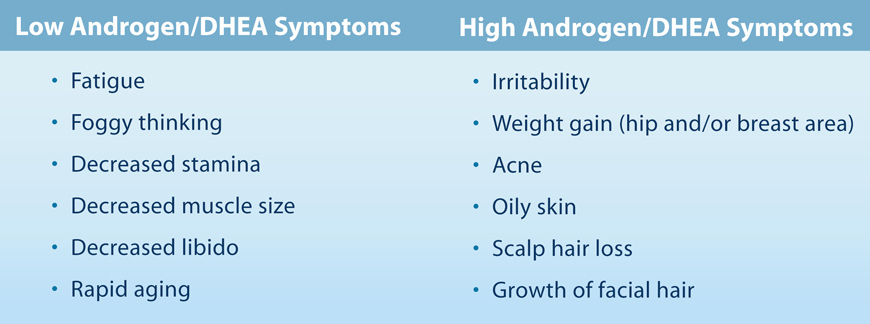Written By Dr. Cheryl Burdette,
Director of Clinical Support & Education For Doctor's Choice

DHEA is known as the “stress” hormone. This is because we make more DHEA under times of stress to help compensate and cope with stressful events. Better levels of DHEA are associated with many positive benefits, and can minimized the impact of stress on the body. DHEA is made predominantly by the adrenal glands, and diagnostic measurements lets us know how they are functioning. A review of the literature shows that DHEA shows many positive attributes, and adds clinical value when monitored routinely as part of the Functional Health Report from Doctor’s Choice.
DHEA is a steroid hormone made by the adrenals. DHEA is converted downstream into testosterone. DHEA is the most abundant steroid hormone in the body, 10,000 fold higher than estrogens for example. DHEA peaks in the mid-twenties and decreases by 20% by the time we are in our seventies. DHEA has many positive effects on the brain as our most abundant neurosteroid. Declining DHEA levels have been associated with Alzheimer’s.1 Independent of age, serum levels of DHEA-S appear to be positively correlated with healthier psychological profiles - executive function, working memory, attention, concentration, enjoyment of leisure activities and overall stress-buffering effect.2

Approximately 98% of circulating DHEA in the bloodstream is the sulfated form (DHEA-S). DHEA-S binds more strongly to albumin, its carrier protein, than DHEA, thus contributing to the slower metabolic clearance from circulation. In addition to the longer biological half-life, DHEA-S does not exhibit a strong diurnal rhythm as seen with cortisol and DHEA, nor does it vary from day to day.3 Additionally, the levels of DHEA-S run in parallel to those of DHEA, and correlate very closely with clinical symptoms of androgen deficiency and excess.4 DHEA-S is most commonly measured in the blood.
Low levels of DHEA are associated with depression, fatigue, anxiety, bipolar and brain fog. However, levels that are elevated have been associated with anger as well at PTSD. DHEA helps neurotransmitter functionality. For example, DHEA-S increases the activity of tyrosine hydroxylase which increases production of dopamine. DHEA also improves release of serotonin further aiding brain chemistry. Those who experience depression also have difficulty in comparison to controls in terms of making DHEA in response to stress. DHEA therapies are useful in cognitive function.
DHEA-S should be higher than cortisol levels. Many studies have shown a higher DHEA:cortisol ratio to be associated with better health outcomes. In postmenopausal women, this ratio was looked at, and the better the ratio, the lower their risk of heart disease, metabolic syndrome, and cancer. A walking program was found to improve this ratio for women. The higher the adherence to walking the more their ratio of DHEA to cortisol improved.5 DHEA-S is associated with better bone density, in men as well as women.6
Other conditions that have shown benefit to DHEA therapy include:

Understanding levels of DHEA is critical in our understanding of age related conditions. Consistent measurements as on the FHR will help our patients maintain optimal function.
1 Murialdo G, Nobili F, Rollero A, Gianelli MV, Copello F, Rodriguez G, Polleri A: Hippocampal perfusion and pituitary-adrenal axis in Alzheimer's disease. Neuropsychobiology 2000;42:51-57.
2 Maninger N, Wolkowitz OM, Reus VI, Epel ES, Mellon SH: Neurobiological and neuropsychiatric effects of dehydroepiandrosterone (DHEA) and DHEA sulfate (DHEAS). Front Neuroendocrinol 2009;30:65-91.
3 Starka L, Duskova M, Hill M: Dehydroepiandrosterone: a neuroactive steroid. J Steroid Biochem Mol Biol 2015;145:254-260.
4 Kamin HS, Kertes DA: Cortisol and DHEA in Development and Psychopathology. Horm Behav 2016.
5 Women Health. 2017 Mar 22. doi: 10.1080/03630242.2017.1310168. [Epub ahead of print]
Walking Training and Cortisol to DHEA-S Ratio in Postmenopause: an Intervention Study.
Di Blasio A1, Izzicupo P2, Di Baldassarre A2, Gallina S3, Bucci I1, Giuliani C1, Di Santo S1, Di Iorio A4, Ripari P5, Napolitano G1.
6 J Bone Miner Res. 2017 Mar 9. doi: 10.1002/jbmr.3123. [Epub ahead of print]
Low Serum DHEAS Predicts Increased Fracture Risk in Older Men: The MrOS Sweden Study.
Ohlsson C1, Nethander M2, Kindmark A3, Ljunggren Ö3, Lorentzon M1,4, Rosengren BE5, Karlsson MK5, Mellström D1,4, Vandenput L1.